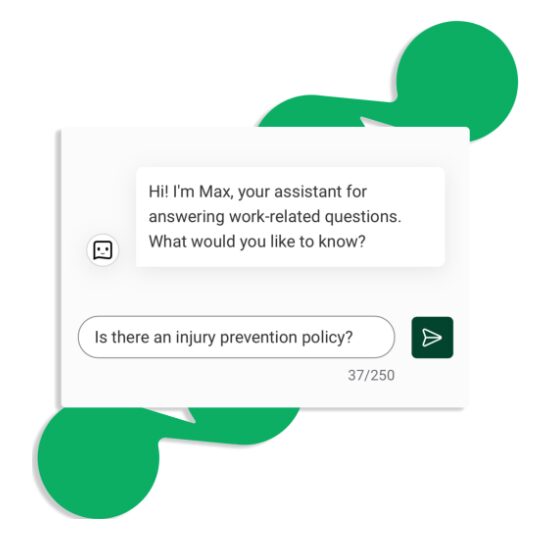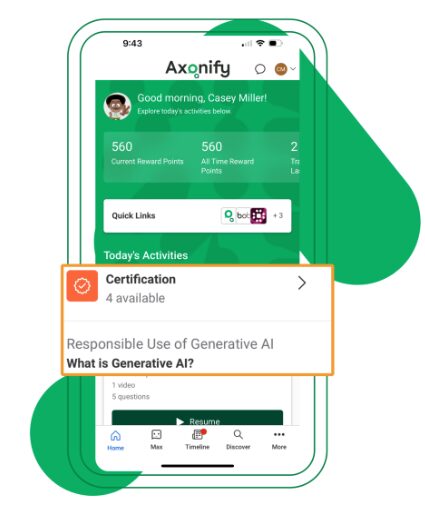5 ways AI is driving elearning trends (2025 edition)

There’s no question: AI is transforming how work gets done.
78% of companies apply AI in at least one business function, up from 55% in 2023, according to McKinsey. And this momentum isn’t slowing down with 92% planning to increase their AI investments over the next three years.
Technology is reshaping how products are built, how customers are served – and how employees build the knowledge and skills they need to perform. AI in L&D: The State of Play reveals that 55% of organizations already apply AI in their L&D practices. Hands-on and classroom training still dominate, but AI is speeding up the move to digital enablement. In fact, one-third of all training hours now happen online and 66% of organizations integrate video into their frontline training as noted in ATD research.
This shift represents a huge opportunity to make workplace learning more accessible, more personalized and more impactful. This is especially true on the frontline, where packed schedules and nonstop workloads make it impossible for people to step away for classroom training. As a result, many employees miss out on development altogether. According to The Deskless Report, 43% of frontline managers and 35% of workers say lack of training is making their day-to-day more difficult.
Here are 5 ways AI is transforming digital workplace training.
1. Faster content development
One of the biggest challenges in delivering right-fit training, especially on the frontline, is capacity. When you’re supporting large, distributed teams, L&D can only do so much with limited time and resources. This means some problems go unaddressed, and some people get left behind.
AI flips the script. By accelerating key parts of the content development process, AI enables L&D to do more with the same resources. Now, you can tackle more challenges, support more employees and please more stakeholders.
At Axonify, we apply generative AI to help content creators apply our proven learning methodology, including principles like spaced learning and reinforcement. Designers co-create assets like reinforcement questions directly from source material in a fraction of the time.
Of course, everything still gets reviewed by the right people before it reaches employees. But AI is helping teams move faster and scale training so frontline workers can build critical knowledge and apply it confidently on the job.
👉 Learn more about Axonify’s AI-powered Content Assistant
2. More engaging digital experiences
“Click next to continue” is the most dreaded phrase in corporate training.
Even when people do make time for digital learning, the experience often falls flat. The bar for engagement is set on YouTube and Instagram. Corporate slide decks and generic eLearning modules just don’t cut it anymore.
Thankfully, there’s an AI fix. Not only can modern authoring tools help you build content faster, but they can also boost engagement so employees stay focused, absorb the message and apply what they learn. No more scrolling TikTok on your phone while waiting for the narration to finish.
At Axonify, we partnered with Vyond to launch Content Studio, giving teams the power to personalize hundreds of topics from the Axonify Content Marketplace using AI. Studio includes built-in AI avatars, so you can easily drop a digital presenter into your online training and provide a more human touch to your digital content. Plus, there’s no need to worry about costly video shoots or expensive updates. Just tweak the script, and the avatar delivers the new message instantly.
👉 Check out Axonify Content Studio featuring AI avatars
3. Automated translation
AI is doing more than speeding things up. It’s also helping more people access the information they need to do their jobs well.
Localization has long been a sticking point in corporate training. Translating content takes time and money, so most companies only support a handful of languages. Some people get left behind entirely while others struggle to make sense of information that wasn’t built for them.
AI is rapidly solving this problem by automating content translation and reducing the need for expensive, manual services.
At Axonify, we apply AI to translate information across the digital experience. This includes training materials, messages and social updates. Each employee chooses their preferred language while content creators localize materials in just a few clicks. And those avatars I mentioned earlier? They can speak dozens of languages, too!
Important content—like compliance training and SOP updates—should still be reviewed by fluent speakers. But AI translation keeps getting better, making it easier to support every employee, no matter where they work or what language they speak.
4. Adaptive learning at scale
Digital learning is easier to access. Employees can engage with content via mobile devices without leaving the floor. But if the content is generic and irrelevant, it won’t matter. Ease of access doesn’t equal impact.
Instead, organizations must ensure each person gets the right training at the right time to maximize their potential and drive business outcomes. This is difficult-to-impossible when you’re supporting thousands (or even hundreds of thousands) of employees across job sites.
Enter AI.
At Axonify, we apply data from across the employee experience to personalize learning from day one. Rather than push everyone through the same path, Axonify adapts to each person based on their proven knowledge, job performance and results. Even workers in the same role get completely different support tailored to their individual needs.
With adaptive learning, you can fast track new hires into the operation, reduce time wasted on irrelevant content and boost engagement because employees receive useful information every time they log in.
AI makes adaptive learning at scale possible while enabling L&D teams to work smarter, move faster and deliver measurable business results.
👉 Watch this demo of the Axonify adaptive learning experience
5. Reliable, on-demand support
Too often, employees are left guessing when they run into a new problem. Maybe they never received training on that task. Maybe they just don’t remember what they learned six months ago. Either way, they end up wasting time digging through SharePoint folders when they should be focused on your customers.
AI is fixing the SharePoint problem. Digital assistants help employees confidently solve problems, make informed decisions and keep the operation moving. They transform your organization’s curated knowledge into on-demand performance support. Employees can ask questions in plain language and get answers they actually understand, even in their preferred language.
This is why we built Max, Axonify’s digital assistant for frontline teams. Max taps into your SOPs, training content, product sheets—whatever you’ve got—to get employees the information they need, when they need them. No more chasing down managers. No more telling customers “I don’t know.”
Just quick, reliable answers that help your people do great work every shift.
AI is changing everything
AI isn’t on the horizon. It’s already here. Everything we’ve explored is happening today. AI is transforming how L&D teams support employees and deliver measurable business impact.
If you’re struggling to reach people with timely support…
If content takes months to build and becomes outdated before it launches…
If you’re constantly playing catch-up with stakeholder demands…
If great resources continue to go unused…
AI is the key to unlocking the potential of your employees and organization.
Are you ready to open the door? Speak with an expert today.

